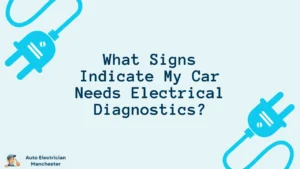
Car troubles can be a real drag, leaving you stranded or frustrated. But don’t despair! With a little know-how and the right approach, you can tackle many common electrical issues at home, saving time and money. This guide empowers you to become your car’s electrical detective, pinpointing problems and potentially avoiding a trip to the mechanic.
Empowering Yourself Through Troubleshooting
The key to successful troubleshooting lies in a systematic approach. By following a logical process of elimination, you can isolate the problem and identify the culprit behind those electrical gremlins. This guide will equip you with the knowledge and steps to confidently navigate common electrical issues.
Essential Tools and Techniques
1. Safety First
Safety is paramount when working on your car’s electrical system. Always prioritize safety by using insulated tools and avoiding contact with high-voltage components. A multimeter is your trusty companion, allowing you to measure voltage, current, and resistance. This versatile tool plays a vital role in diagnosing electrical faults.
2. Harnessing the Power of Knowledge
Your car’s manual is a treasure trove of information. It contains specific details about your vehicle’s electrical system, including fuse box locations and diagrams. Understanding fuse functions and locations empowers you to identify blown fuses, a prevalent cause of electrical component malfunctions. A blown fuse is easily recognizable by a broken filament inside the transparent casing. Remember, only replace a blown fuse with one having the identical amperage rating.
3. The Art of Observation
Keen observation skills are a valuable asset in electrical troubleshooting. Pay close attention to the nature of the electrical problem. Does it affect the entire electrical system, or is it limited to a specific area, like the instrument cluster or a single headlight? Is there a flickering or dimming effect? Noting these details helps narrow down the potential causes.
Common Electrical Culprits
1. The Battery
The battery is the heart of your car’s electrical system. A failing battery can manifest in several ways, including dim lights, sluggish engine starts, or complete electrical failure. Corrosion on the battery terminals disrupts the flow of electricity. Luckily, this is an easy fix. Clean the terminals with a baking soda and water solution, and ensure a tight connection. A multimeter can measure battery voltage. Generally, a voltage reading below 12.4 volts indicates a weak battery nearing the end of its lifespan (typically 3-5 years).
2. Illuminating the Problem
Faulty or flickering lights can point to various electrical issues. A failing alternator, responsible for charging the battery, might not be providing enough power. This is often signaled by dimming headlights while the engine is idling. Check for loose or corroded bulb connections within the light housing itself. These relatively simple fixes can restore proper illumination.
3. The Silent Culprit
Fuses act as safety guards within your car’s electrical system. They prevent excessive current flow that could damage electrical components. A blown fuse can cause specific electrical components to shut down. A visual inspection can identify a broken filament within the fuse. If you find a blown fuse, consult your car’s manual to identify the correct replacement with the same amperage rating.
4. Seeking Help When Needed
Remember, safety is paramount. For complex electrical problems or tasks requiring access to high-voltage components, consulting a qualified mechanic is highly recommended. Don’t hesitate to seek professional help for issues beyond your comfort zone.
Advanced Troubleshooting Techniques
While the previous section addressed common electrical issues, some problems require a more in-depth approach. Here, we’ll delve into some advanced troubleshooting techniques to equip you for tackling more complex electrical gremlins.
1. Harnessing the Power of the Multimeter
Your multimeter becomes even more crucial for advanced troubleshooting. Here’s how to leverage its functions for electrical diagnosis:
Voltage Testing: Measure voltage across various points in the electrical system, such as the battery terminals, alternator output, and fuse box inputs and outputs. Deviations from expected voltage readings can pinpoint issues with the battery, alternator, or wiring.
Current Measurement: In certain situations, measuring current draw can be helpful. This is typically done by placing the multimeter in series with a specific circuit. An abnormally high current draw may indicate a short circuit or a malfunctioning component.
Resistance Testing: Measuring resistance across components or wires can help identify breaks or faults within the circuit. A reading of infinite resistance (overload) signifies an open circuit, while a very low resistance reading (short circuit) indicates excessive current flow.
2. Illuminating the Circuit
A simple test light can be a valuable tool for initial electrical checks. It provides a quick way to verify if a circuit has power. Touch the test light probe to various points in the circuit while grounding the clip on a metal component. If the light illuminates, it indicates the presence of current. While not as precise as a multimeter, a test light offers a fast and easy way to trace current flow and identify potential trouble spots.
3. Following the Blueprint
Understanding wiring diagrams is a valuable asset for complex electrical troubleshooting. These diagrams illustrate the electrical layout of your car, showing how different components are interconnected. By referencing the wiring diagram specific to your car model, you can trace the path of a circuit and pinpoint potential trouble spots based on the symptoms you’re experiencing. Wiring diagrams can be found in your car’s repair manual or online through paid subscription services.
Conclusion
By following these steps and wielding the power of knowledge, you can effectively troubleshoot many common electrical issues in your car. Remember, this guide equips you to handle basic electrical concerns, potentially saving you time and money. So, the next time your car throws an electrical tantrum, approach it with confidence, armed with the knowledge from this guide!
FAQ
Can I troubleshoot a dead battery at home?
Yes, in many cases. You can check for loose or corroded battery terminals and clean them with a baking soda and water solution. If the battery appears healthy but your car won’t start, you might have a problem with the starter motor or another electrical component. In such cases, seeking a mechanic’s help is recommended.

David Mack is a seasoned writer with a passion for the auto electrician niche. With years of hands-on experience and a knack for demystifying complex topics, David brings practical insights to his readers. Whether you’re a professional or a car enthusiast, his engaging articles offer valuable tips and trends in auto electrical systems.
